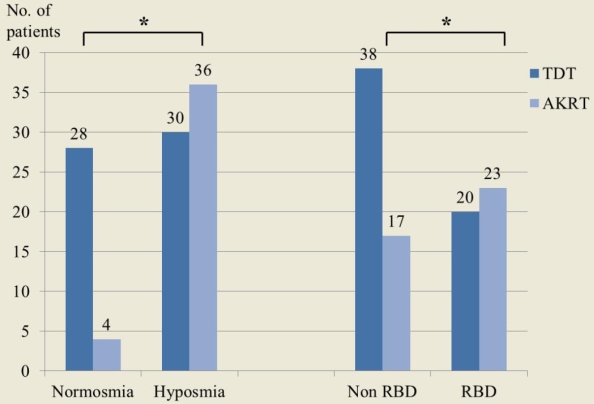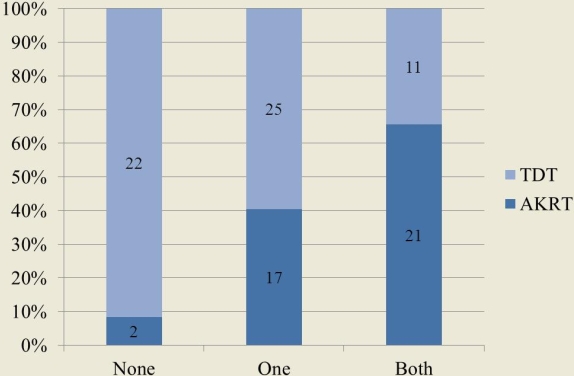Session Information
Date: Monday, June 20, 2016
Session Title: Parkinson's disease: Non-motor symptoms
Session Time: 12:30pm-2:00pm
Location: Exhibit Hall located in Hall B, Level 2
Objective: We investigated the relationship between olfactory impairment, REM sleep behavior disorders (RBD), initial cognitive performance and motor phenotype in Parkinson’s disease (PD).
Background: Olfactory dysfunction and RBD are recognized as pre-motor symptoms of PD. Cognitive dysfunction is observed at a high rate even in the early stages of PD as an important non-motor symptom. PD has been classified in different subtypes and it is unknown if olfactory dysfunction and RBD occur more often in one particular subtype.
Methods: Nighty-eight patients with drug-naïve idiopathic PD who visited the Movement Disorders Unit of Korea University Guro Hospital, Seoul, Korea from March 2012 to February 2014 were retrospectively included. Patients were divided into tremor-dominant-type and akinetic-rigid-type PD subgroups using part III of the Unified Parkinson’s disease Rating Scale. Olfaction was assessed by the Cross Cultural Smell Identification Test. RBD was screened using screening questionnaires. Initial cognitive function was assessed with Mini–Mental State Examination.
Results: The PD-normosmia group had higher MMSE scores (p=0.008). PD patients who have both RBD and olfactory dysfunction had lower MMSE scores (P=0.013). Presence of both RBD and hyposmia in PD patients was more strongly correlated with poor cognitive dysfunction.Thirty eight (69%) patients among the non-RBD group (n=55) and 20 (47%) patients among the RBD group (n=43) had tremor-dominant phenotype (odds ratio=2.57, p=0.024).  There were significant differences in the proportion of patients with the motor phenotype between the groups according to the presence of olfactory dysfunction and RBD (p<0.001).
There were significant differences in the proportion of patients with the motor phenotype between the groups according to the presence of olfactory dysfunction and RBD (p<0.001). 
Conclusions: Olfactory dysfunction and RBD differed according to the motor phenotypes of PD. This suggests that olfactory dysfunction and RBD might relate to prognosis in patients with PD. Patients who have both hyposmia and RBD were more likely to exhibit cognitive dysfunction.
To cite this abstract in AMA style:
S.B. Koh, S.H. Kang, H.M. Lee, W.K. Seo, J.H. Kim. The combined effect of REM sleep behavior disorder and hyposmia on cognition and motor phenotype in Parkinson’s disease [abstract]. Mov Disord. 2016; 31 (suppl 2). https://www.mdsabstracts.org/abstract/the-combined-effect-of-rem-sleep-behavior-disorder-and-hyposmia-on-cognition-and-motor-phenotype-in-parkinsons-disease/. Accessed April 1, 2025.« Back to 2016 International Congress
MDS Abstracts - https://www.mdsabstracts.org/abstract/the-combined-effect-of-rem-sleep-behavior-disorder-and-hyposmia-on-cognition-and-motor-phenotype-in-parkinsons-disease/
